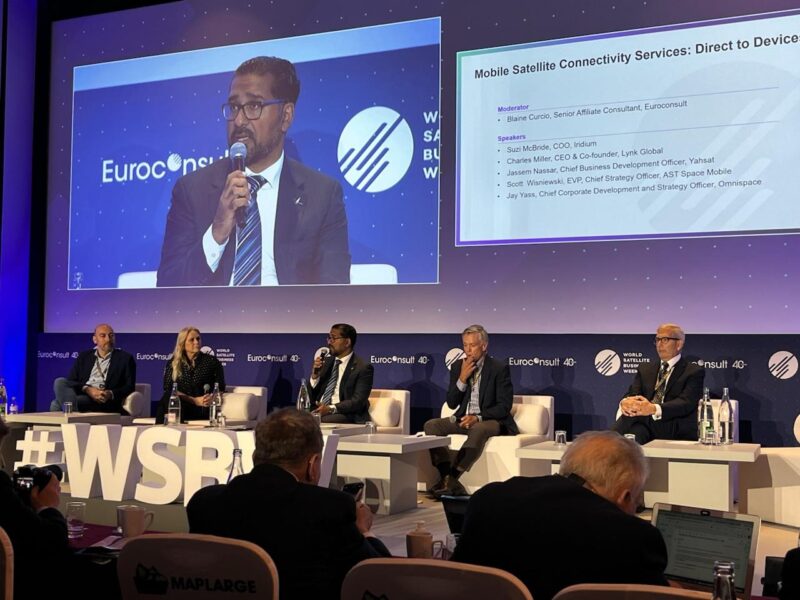How Big is the Satellite Industry’s Direct-to-Device Opportunity?

Satellite executives discuss direct-to-device opportunities at World Satellite Business Week in Paris (photo: Rachel Jewett)
PARIS — Direct-to-device, satellite-to-cell, NTN/non-terrestrial networks — the satellite industry hasn’t come to a consensus on what to call this type of connectivity, but players are making bold projections for its potential revenue and impact.
The term direct-to-device is too “inside baseball,” Lynk Global CEO Charles Miller said Tuesday during a panel at World Satellite Business Week. It’s not understood by regular people outside the industry who could be using these services in the future, he says, and the industry needs to tackle this.
“We need to speak the language of the people who are the customer — the 5 billion people with mobile phones. The right language for this category is critical for all of us to figure out,” Miller said. “This is the first service that executes the promise that satellites had at the beginning of the space age. We are going to connect everybody, everywhere, to the phone in their pocket. We should use language that talks to people, that they understand.”
Miller’s projection is that the direct-to-device industry will be worth $1 billion in less than five years. Lynk has contracts with 34 mobile network operators. It has started initial beta service in three countries and many more to come, he said. Miller also said that Lynk raised $20 million dollars in recent months and will soon raise a new tranche of capital as well.
AST SpaceMobile was Lynk’s closest competitor on the panel. While the company’s take different technology approaches with their satellites, they are pursuing a similar business model of partnering with MNOs and see similar market opportunities.
Scott Wisniewski, AST SpaceMobile chief strategy officer, said he thinks the end user will be willing to pay more for their phone plan for this service to ensure they are connected at all times. With the number of potential subscribers, the end user would not have to pay much for the business case to close, he said.
While AST SpaceMobile has agreements with more than 40 MNOs, the company does not make service revenue from these agreements at this point, Wisniewski said.
Jay Yass, chief corporate development and strategy officer of Omnispace, believes this type of connectivity will be widespread in the next four to eight years, but not just with cell phones, with any connected devices. He predicts that by using 3GPP standards, future NGSO constellations will have access to 1 billion or more compatible devices already on the market, like shark fins for connected cars.
Omnispace, which has two LEO S-band satellites in orbit, recently finished a study with a “major manufacturer” for the design and architecture of an NGSO constellation.
Yass described it as an NGSO system for 5G NTN connectivity on a global basis, using mid-band, licensed spectrum, and hinted at upcoming announcements of technology providers. Yass did not mention a partner, but Omnispace and Ligado have an MoU in this area.
“We’ve also had discussions with semiconductor and device manufacturers, which are really key to the ecosystem to launch this for direct-to-device,” Yass said. Omnispace has signed about 24 global mobile network operators that are interested in a 3GPP seamless augmentation to their terrestrial networks.
Yahsat, which connects specialized satellite phones with Thurauya, is looking at getting into the direct-to-device market as well, and the UAE satellite provider recent released an RFI to the industry for a Non-Geostationary Orbit (NGSO) constellation focused on direct-to-device, said Jassem Nassar, chief business development officer of Yahsat.
Nassar said Yahsat is looking for capabilities for texting, voice and some data capability, with the ability to offer broadband in the future.
While there’s been a flurry of announcements on satellite-to-cell partnerships with everyone from Vodafone, T-Mobile, Apple, and Qualcomm getting involved, the adoption is still in the early stages. Some players like Lynk and AST SpaceMobile need to raise significant amounts of money to be able to deploy their full constellations.
Iridium, for example, is partnered with Qualcomm to enable satellite connectivity in the Snapdragon chip, but activations won’t start until 2024, and Samsung hasn’t adopted the chip yet.
Iridium COO Suzi McBride cautioned for a measured take on the potential here, arguing it will take 10 years before there is widespread adoption with many satellites on orbit dedicated to this, and service agreements.
“We as an industry have to be clear and manage expectations for the customers, if you want to take lessons learned from Iridium the first time around,” McBride said, referencing how Iridium’s first generation did not live up to expectations. “We have to be very cautious that we manage expectations properly so that it is successful long term.”